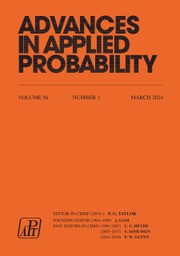Article contents
Almost sure convergence and second moments of geometric functionals of fractal percolation
Published online by Cambridge University Press: 28 November 2023
Abstract
We determine almost sure limits of rescaled intrinsic volumes of the construction steps of fractal percolation in  ${\mathbb R}^d$ for any dimension
${\mathbb R}^d$ for any dimension  $d\geq 1$. We observe a factorization of these limit variables which allows one, in particular, to determine their expectations and covariance structure. We also show the convergence of the rescaled expectations and variances of the intrinsic volumes of the construction steps to the expectations and variances of the limit variables, and we give rates for this convergence in some cases. These results significantly extend our previous work, which addressed only limits of expectations of intrinsic volumes.
$d\geq 1$. We observe a factorization of these limit variables which allows one, in particular, to determine their expectations and covariance structure. We also show the convergence of the rescaled expectations and variances of the intrinsic volumes of the construction steps to the expectations and variances of the limit variables, and we give rates for this convergence in some cases. These results significantly extend our previous work, which addressed only limits of expectations of intrinsic volumes.
Keywords
- Type
- Original Article
- Information
- Copyright
- © The Author(s), 2023. Published by Cambridge University Press on behalf of Applied Probability Trust
References
- 1
- Cited by



